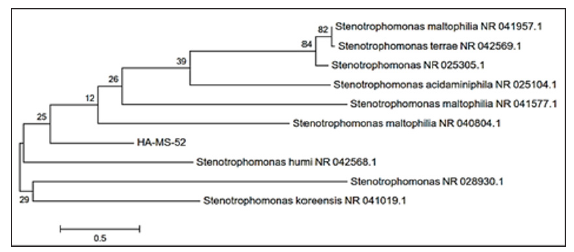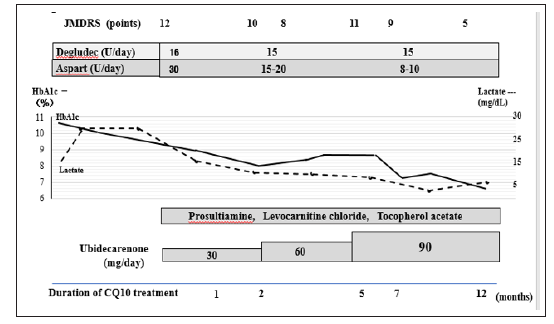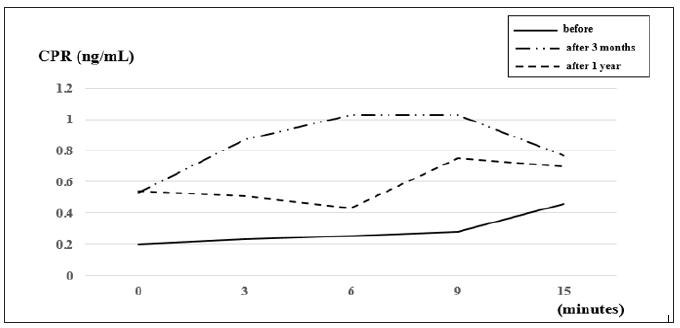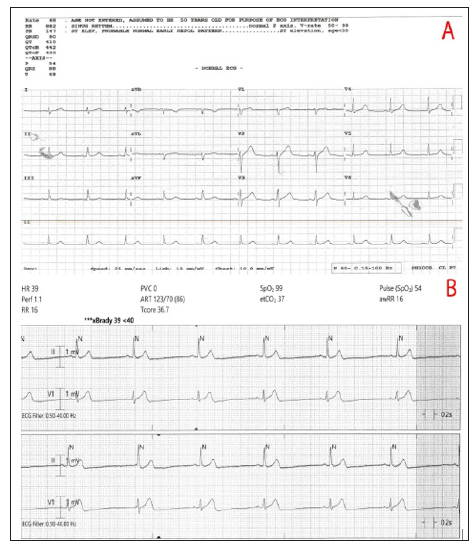Integrated in Silico Docking and MOMA Simulation Methods Reveal Rottlerin as a Potent Janus kinase 2 (JAK2) Inhibitor
Abstract
Janus kinase 2 (JAK2) is a prospective drug target for
myeloproliferative neoplasms, mainly polycythemia Vera, essential
thrombocythemia and primary myelofibrosis disorders. JAK2 abnormalities
are mainly identified in myeloid neoplasms. Multiple type I
ATP-competitive JAK inhibitors with various specificities displayed
potent anti-inflammatory activity with minimum hematologic toxicity in
clinical trials. Therefore, only two tyrosine kinase inhibitors have
been approved by Food and Drug Administration (FDA) as follows: first
tyrosine kinase inhibitor is JAK2/JAK1 inhibitor (ruxolitinib 1) in
intermediate-2 and high-risk myelofibrosis and hydroxyurea-resistant or
-intolerant polycythemia Vera. Second tyrosine kinase inhibitor is
JAK1/JAK3 inhibitor (tofacitinib. 2) in methotrexate-resistant
rheumatoid arthritis. However, the potent-antiinflammatory effects of
JAK inhibitors seem to be logical therapeutic approach for various
inflammatory and auto-immune diseases. Extensive research has identified
the chemotherauperic potential of plant-derived compounds of which
rottlerin (5) exhibited great potentiality since rottlerin (5)
influences various cell mechanisms involved in cell survival, autophagy,
apoptosis and invasion. Rottlerin (5) activity is presumed to result
from a combination of signaling pathways at multiple levels.
Bioinformatics’ tools were utilized to identify the specific targets for
different ligands. In silico predictions, modeling and dynamic
simulations based on the crystal structure of JAK2 and ligands were
performed. Active molecular docking studies using AutoDock Vina software
suggested that rottlerin (5) is a novel inhibitor of JAK2 with binding
affinities of –9.3 kcal/mol when compared to approved drugs ruxolitinib
(1) (-8.7 cal/mol and tofacitinib (2) (-7.4kcal/mol). Of these ligands
investigated in this study, rottlerin (5) produced the greatest JAK2
binding affinity. The data suggests that rottlerin (5) could be explored
as potent lead compound to treat myelofibrosis caused by JAK2
overexpression.
Keywords: Janus kinase 2; Myelofibrosis; Docking Studies; In Silico; Apigenin; Gandotinib; Ruxolitinib; Rottlerin; Tofacitinib; Wogonin
Abbreviations: ARG: Argenine; ASN:
Aspertine; Glu: Glutathione; Gly: Glycine; LYS: Lysine; PHE:
Phenylalanine, VAL: Valine; JAK 2: Janus Kinase 2; ET: Thrombocythemia;
MPDs: Myeloproliferative disorders; PV: Polycythemia Vera; PMF: Primary
Myelofbrosis
Introduction
Janus kinase 2 (JAK2) is a non-receptor tyrosine kinase. Janus kinase
family (JAK1, JAK2, JAK3 and TYK2) was associated with signaling by
members of the type II cytokine receptors (e.g. interferon receptors),
gp130 receptors (e.g. IL-6R), GM-CSF receptors (IL-3R, IL-5R and
GMCSF-R), and single chain receptors (e.g. Epo-R, Tpo-R, GH-R, PRL-R)
[1,2]. JAK/STAT signaling pathway plays imperative part in many
physiological processes in response to various extracellular stimuli and
cytokines. The Janus kinase family (JAK1, JAK2, JAK3 and TYK2) plays a
crucial role in cytokine and growth factor mediated Janus kinase/signal
transducers and activators of transcription (JAK/STAT) signal
transduction [3]. JAK
auto-phosphorylation leads to dimerization of phosphorylated STAT
proteins and their translocation into the nucleus, thereby increasing
cellular proliferation and resistance to apoptosis [4]. Myelofibrosis is
a group of rare cancers of bone marrow and is classified as chronic
leukaemia. Among the Janus kinase family, JAK2 was proved to be
associated with the pathogenesis of myeloproliferative disorders (MPDs),
primarily including polycythemia Vera (PV), essential thrombocythemia
(ET), and primary myelofbrosis (PMF) [5-7].
In particular, the essential role in cell growth and survival makes
JAK2 an important target for cancer treatment [8,9]. However,
ruxolitinib (1) was the only JAK1/JAK2 inhibitor that was approved for
clinical use to treat myelofibrosis and hydroxyurearesistant-
moderate-2 and high risk myelofibrosis and hydroxyurearesistant
or intolerant polycythemia Vera. In addition, tofacitinib
(2) was approved JAK1/JAK3 inhibitor to treat methotrexateresistant
rheumatoid arthritis. JAK inhibitors often exhibit potential
anti-inflammatory activity and thus could be useful in chronic
inflammation treatment. Therefore, research had been diverted
to discover other JAK1/JAK2 inhibitors with better drug-like
properties with novel structural skeleton and fewer side effects.
Furthermore, non-approved JAK inhibitors displayed numerous offtarget
effects leading to undesired neurological and gastrointestinal
toxicities in myeloproliferative neoplasm associated clinical trials
[10]. Recently, several small molecules belonging to different class
of natural products were reported to regulate JAK/STAT pathway
[12]. Among these, apigenin (3) and wogonin (4) have been found
to inhibit IL-1-induced STAT1/2 activation via inhibition of JAK2
activation, leading to MMP-13 down-regulation in SW1353 cells
(human chondrosarcoma cell line) [13].
Rottlerin (5) ((E)-1-[6-[(3-acetyl-2,4,6-trihydroxy-5-
methylphenyl) methyl]-5,7-dihydroxy-2,2-dimethyl-chromen-8-
yl]-3-phenyl-prop-2-en-1-one) also known as mallotoxin, is the
principal phloroglucinol derivative of kamala dye obtained from
Mallotus philippinensis [14]. Rottlerin (5) inhibited many other
protein kinases, such as MAPKAPK5 (PRAK), MAPKAP-2, Akt/
PKB, and calmodulin-dependent protein kinase (CaMK) [15].
Rottlerin (5) uncoupled mitochondrial respiration from oxidative
phosphorylation, thereby reducing adenosine triphosphate
(ATP) levels and affected several cellular functions [13]. In
pancreatic acinar cells, rottlerin (5) modulated several biological
and biochemical processes in a PKCδ-independent pathway. In
addition, rottlerin (5) (6M) depleted ATP levels, consequently
averted the phosphorylation of many signaling proteins and
inhibited enzymatic secretion and several intracellular pathways,
in a PKCδ-independent manner. As a result, the inhibitory effects
of rottlerin (5) were mimicked by the mitochondrial uncouplers
carbonylcyanide m-chlorophenylhydrazone and carbonyl cyanide
p-trifluoromethoxy phenylhydrazone, in pancreatic acini [16].
Cancers are caused by deregulation of hundreds of genes. An ideal
anticancer agent should target multiple gene products or signaling
pathways simultaneously without effecting normal cells. Recently,
extensive research was focused on the chemotherapeutic potential
of plant-derived compounds. Rottlerin (5) inhibited cell growth,
induced apoptosis, arrested cell cycle, and retarder cell invasion as
well as migration.
Furthermore, rottlerin (5) suppressed Skp2 expression
and subsequently exerted its tumor suppressive function in
pancreatic cancer cells, suggesting that rottlerin (5) might be a
potential therapeutic target for treating pancreatic cancer [14].
Among the ever-increasing list of naturally occurring anticancer
agents, rottlerin (5) was effective in chemotherapy because of
its influence on several cellular machineries involved in survival,
apoptosis, autophagy, and invasion [17]. In a recent study, rottlerin
emerged as the most potent metastasis-associated in colon cancer
1 transcriptional (MACC1) inhibitors [18]. Rottlerin (5) anticancer
activity resulted from combination of signaling pathways
at multiple levels. Furthermore, the underlying mechanisms
described for rottlerin (5) anticarcinogenic activity were diverse
and cell-specific [14]. Molecular docking is a computer-based drug
design that initiates the docking of a ligand into the active site of the
receptor. The motive of receptor and ligand docking interactions
can be predicted through three-dimensional visualization of the
docked complexes. This research was conducted to explore the
binding interactions between receptor protein and the three
naturally rottlerin (5) along with JAK known inhibitors, ruxolitinib
(1), tofacitinib (2) and gandotinib (6) (Figure 1).
Figure 1: Ruxolitinib (1), Tofacitinib (2), Apigenin (3), Wogonin (4), Rottlerin (5), Gandotinib (6)
Materials and Methods
Protein Preparation
Homology Modeling of the 4AGC Protein: Homology
modeling methods make use of experimental protein structures
(“templates”) to build receptor proteins in drug discovery.
Homology (or comparative) modelling is currently the most
accurate method to generate reliable three-dimensional protein
structure models. SWISS-MODEL is a structural bioinformatics
web-server dedicated to homology modelling to predict protein
3D structures [19,20]. Janus kinase 2 (PDB ID: 4AGC), protein
structure retrieved from protein data bank (http://www.rcsb.org/)
was missing some amino acid residues. The complete JAK2 protein
was modelled by submitting FASTA sequence of 4AGC (chain A)
protein into SWISS-MODEL Workspace through automated mode
for the development of a more accurate protein model [21]. The
4AGC (Chain A) protein and its sequence were selected as the target
protein and query sequence, respectively. The crystal structure of
JAK2- (PDB ID: 2W1I) was also obtained from the protein data
bank. The 4AGC protein model was built by using the 2W1I protein
as a suitable template. In the SWISS MODEL Workspace automated
mode, fifty templates of query sequence were generated. The
template, 2W1I.1.A, demonstrated highest sequence identity to
query sequence and was used to develop an improved model of
the 4AGC protein. Global quality estimate, local quality estimate
comparison and 4AGC model template alignment with 2W1I.1.A
were calculated (Figure 2) [22,23].
Figure 2: Global quality estimate, local quality estimate comparison and 4AGC model template alignment with 2W1I.1. A.

Modeled JAK2 Protein Validation: The 4AGC-Modeled protein
quality was validated by Ramachandran plot using Rampage [24]
and in SPDBV (Deep View – Swiss – Pdb Viewer) version 4.10 based
on the RMSD value obtained by superimposing the 4AGC protein
model on its model template 2W1I [25]. 4AGC-Modeled protein
was selected for molecular docking to acquire reliable prediction
of ligands ability to bind with the receptor. The quality of 4AGCModeled
protein was validated by comparing Ramachandran plots
of 4ACC, 2W1I and modeled 4AGC using Rampage [24]. A New
generation of crystallographic validation tools for the protein data
bank and in SPDBV (Deep View – Swiss – Pdb Viewer) version 4.10
based on RMSD value obtained by superimposing 4AGC protein
model on its model [25]. Ramachandran plot values of the 4AGC,
4AGC-Modeled protein and its template 2W1I.1.A were obtained
(Table 1). In Ramachandran plot generated for 4AGC protein,
96.8% of amino acid residues were found in favored region, 2.8%
residues in allowed area, and 0.4% of residues were present in
outlier regions (Figure 3). Ramachandran plot of 2W1I.1.A showed
94.6% residues in favored region, 4.0% residues in allowed
region, and 1.4% of residues in outlier regions. Ramachandran
plot generated for 4AGC-Modeled protein displayed 97.2%, 2.1%
and 0.7% of residues in the favored, the allowed, and the outlier
regions, respectively. Ramachandran plot data for 4AGC-Modelled,
6FTU and 2W1I proteins suggested favorable reliability of 4AGCModelled
protein for subsequent docking studies (Table 1) (Figure
3).Energy Minimization and Refinement of the Modeled 4AGC
Protein (4AGC-Modeled): The modeled 4AGC (4AGC-Modelled)
protein valency and chemistry were rectified using Chimera (UCSF,
San Francisco, CA, USA). Energy minimization and refinement were
performed by employing CHARMm force field in order to obtain a
protein with least energy [26,27]. Later, polar hydrogen atoms were
added to the protein model using Auto Dock tools 4.2.6 screening
tool and PyRx v0.8 software (http://pyrx.sourceforge.net/).
Receptor Cavity Prediction: The cavity or the potential ligand
binding site of JAK2 (PDB ID:4AGC) was predicted using MVD with
volume of 174.08 A3 which was identified as active site for docking
using Molegro Virtual Docker (MVD) software. The active binding
cavity was further ascertained through a trail docking run of JAK2
and adenosine triphosphate (ATP) (Figure 4).
Preparation of Ligands
The structures of ruxolitinib (1) (CID: 25126798), tofacitinib
(2) (CID: 9926791), rottlerin (5) (CID: 5281847) and gandotinib (6)
(CID: 46213929) were initially retrieved from PubChem Compound
Database (National Center for Biotechnology Information, U.S.
National Library of Medicine). Molecular geometry optimization of
ligands was achieved using Avogadro (an open-source molecular
builder and visualization tool. Version 1.90.0. http://avogadro.cc/).
The force field MMF94 was set with number of steps 500, algorithm
steepest descent and convergence of 10e-7 [28]. The structures of
ligands were saved in Protein Data Bank (PDB) file format and used
for docking study.
Docking Between JAK2 and Ligands
Discovery Studio visualizer and Chimera (UCSF, San Francisco,
CA, USA) were chosen for visual inspection and preparations. PyRx
software was employed as the virtual screening software. PyRx
includes Auto Dock Vina with a Lamarckian genetic algorithm as
a scoring algorithm. The ligand/protein simulated interactions of
ruxolitinib (1), tofacitinib (2), rottlerin (5) and gandotinib (6) with
JAK2 were determined using Auto Dock Vina (Molecular Graphics
Lab, La Jolla, CA, USA) [28,29]. The docking was conducted with
exhaustiveness of 8 and a grid box with the dimensions for center:
25×25×25 Å and box center: center_x = 31.2851, center_y = 0.4544,
center_z = 2.9915 for 4AGC docking. PyMol v1.3 (Schrodinger, New
York, NY, USA). Auto Dock Vina evaluated target conformation
(biomacromolecule) as a rigid unit while ligands were conceded to
be flexible and adoptable to the target. The software determined
the lowest binding affinity by using different conformations of
each ligand. AutoDock Vina searched for the lowest binding affinity
conformations and determined 9 different conformations for each
receptor and ligand complexes. Each receptor and ligands complex
with the lowest binding energy docking poses were selected.
The protein-ligand interactions were analyzed with LigPlot and
Discovery Studio 4.5 (Dassault Systems BIOVIA, Discovery Studio
Modelling Environment, Release 2017, San Diego, USA).
Docking simulations of target JAK2 with ruxolitinib (1),
tofacitinib (2), rottlerin (5) and gandotinib (6) were performed in
AutoDock Vina. (Molecular Graphics Lab, La Jolla, CA, USA). The
AutoDock Vina software prepared the target in a rigid conformation
while ligands were permitted to be flexible and malleable to the
target. After the completion of docking, ligand conformations
displaying greatest binding affinity and lowest docked energies to
the target were selected. The hydrogen bonds, bond lengths and
hydrophobic interactions between JAK2 and ligands ruxolitinib (1),
tofacitinib (2), rottlerin (5) and gandotinib (6) were determined
by using LigPlot (http://www.ebi.ac.uk/thornton-srv/software/
LIGPLOT/).
Target-Ligand Complex Unbinding Simulations
The MoMA-LigPath web server and Molecular Motion
Algorithms (MoMA) were utilized to simulate ligand unbinding
from the binding site to surface of the target. In addition, server
discloses flexibility of protein side-chains, ligands and includes only
statistical limitations. This process generates mechanistic data on
the pathway of each ligand as it moves from the protein surface
to the binding site or from binding site to surface of the protein.
The program offers molecular interaction graphics, leading the
ligands from surface of protein to the binding site. In this process,
the program identifies certain residues that are crucial factors for
ligand binding or driving ligands towards binding site, in spite of
being away from binding site. The docked molecular complexes
of JAK2 with ruxolitinib (1), tofacitinib (2), rottlerin (5) and
gandotinib (6) that produced the lowest binding energies were
selected for unbinding simulations by using MoMA LigPath [30,31].
Results and Discussion
Autonomous activation of the JAK/STAT pathway is an
important factor in several pathologies. Genetic mutations
targeting this signaling pathway are linked fundamentally with
hematologic malignancies as well as diseases associated with
uncharacteristic cytokine stimulation. The JAK/STAT pathway is
frequently deregulated in malignant diseases caused by irregular
immunological response. One of such disorder is myelofibrosis,
a rare form of cancers of bone marrow where the bone marrow
is replaced by scar tissue failing to produce healthy blood cells
as a result of mutations. BCR-ABL1-negative myeloproliferative
neoplasms initiate unusual activation of JAK2 caused by various
mutations. The discovery of JAK2V617F as the driver mutation
of majority of non-BCR-ABL1 myeloproliferative neoplasms
encouraged the development of JAK inhibitors. Furthermore,
search for JAK2 inhibitors continued following the discovery of
JAK2V617F which revealed that other driver mutations like CALR
and MPL also displayed tenacity in the activation of JAK2 [10].
The interpretation of the protein-ligand interactions
plays an important role in structure-based drug discovery. When
each ligand (1, 2, 5 and 6) was docked with JAK2, different binding
energies were observed. Of these, known JAK inhibitors, tofacitinib
(2) produced the lowest value (-7.4 kcal/mol), compared ruxolitinib
(1) (-8.7 kcal/mol), and gandotinib (6) (-9.1 kcal/mol) whereas
natural product rottlerin (5) generated the greatest binding energy
(-9.3) kcal/mol) when docked with JAK2 receptor. These results
suggest that rottlerin (5) might emerge as a promising candidate
for the inhibition of JAK2 enzyme activity. The present docking
study explored the interactions of ruxolitinib (1), tofacitinib (2),
rottlerin (5) and gandotinib (6) with the receptor protein JAK2 and
their binding patterns with JAK2 amino acid residues ruxolitinib
(1), tofacitinib (2), rottlerin (5) and gandotinib (6) docked with the
active site of JAK2.Each amino acid residue within a 4A0 distance
from ligand was evaluated for the presence of any van der Waals
forces or alkyl, and hydrogen bond interactions.
As a result, ruxolitinib (1), generated 11 van der Waals forces
(Leu 24, Gly 25, Lys 26 , Gly 27, Lys 51, Glu 67, Val 80, Arg 149, Asn
150, Asp 163 and Phe 164) , 5 alkyl interactions (Val 32, Ala 49, Met
98, Ser 105 and Leu 152) and 1 hydrogen bond Asp 108 with JAK2;
while tofacitinib (2) generated 7 van der Waals forces (Gly 25, Lys
26, Gly 27, Val 80, Arg 149, Gly 162 and Asp 163), 3 alkyl interactions
(Leu 24, Val 32, Ala 49, Met 98 and Leu 152), with JAK2; gandotinib
(6) generated 10 van der Waals forces (Gly 25, Lys 26, Gly 27, Ala
49, Pyr 100, Gly 104, Ser 105, Asp 108, Gly 162 and Asp 163), 5 alkyl
interactions (Leu 24, Val 32, Val 80, Met 98, Arg 149 and Leu 152),
1hydrogen bond (Asn 150) with JAK2 residues whereas rottlerin
(5) generated 8 van der Waals forces (Lys 26, Gly 25, Gly 27, Tyr
100, Leu 101, Gly 104, Asn 150 and Asp 163 ), 4 alkyl interactions
(Leu 24, Val 32,Ala49 and Leu 152), 4 hydrogen bonds (Ser 105, Asp
108, Arg 107 and Arg 149) with JAK2 residues. Collectively, these
results suggested that rottlerin (5) might function as excellent JAK2
inhibitor since it produced the highest binding energy (-9.3 Kcal)
(Figure 5).
Conclusion
Myelofibrosis is a cluster of rare bone marrow cancers also
known as chronic leukemia that belongs to certain type of blood
disorders-myeloproliferative ailments. In case of mylofibrosis
one blood stem cell inherits the capacity to reproduce without
any regulation and thus generating large numbers of immature
blood cells leaving little room for healthy cells. The discovery of
JAK2 mutations initiated the discovery of a targeted therapy for
myelofibrosis. BCR-ABL1-negative myeloproliferative neoplasms
are associated with abnormal JAK2 activation. Most often, the JAK/
STAT pathway is disrupted in malignant disorders with abnormal
immunological responses. The discovery of JAK2V617F as a
driver mutation of majority of non-BCR-ABL1 myeloproliferative
neoplasms in 2005 led to the development of JAK inhibitors.
At present, ruxolitinib (1) is the sole FDA approved medication
available for the treatment of myelofibrosis.
Our present in silico docking study suggested that rottlerin
(5), a natural product displayed strong interactions with JAK2
through hydrogen bonds, van der Waals and alkyl forces with
binding energy -9.3 kcal/mol. Additionally, unbinding simulation
studies on: ruxolitinib (1), tofacitinib (2), gandotinib (6) and
rottlerin (5) in complex with JAK2 revealed that rottlerin (5) took
a longer time to unbind from JAK2, compared to ruxolitinib (1),
tofacitinib (2) and gandotinib (6). In addition, these data supported
our in silico observations for rottlerin (5). The current docking
investigations strongly support future research to evaluate the
potential of rottlerin (5) as JAK2 inhibitors in the treatment of
myeloproliferative neoplasms. In summary, these results suggested
that rottlerin (1) might function as better JAK2 inhibitor and should
be explored further as a potential solution for the treatment of
myelofibrosis.











